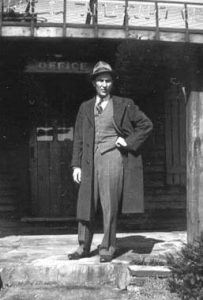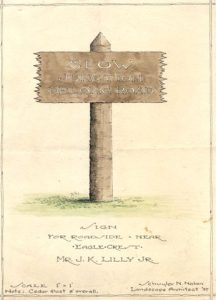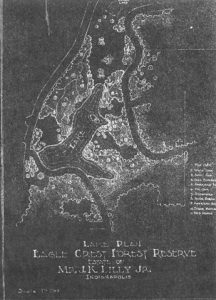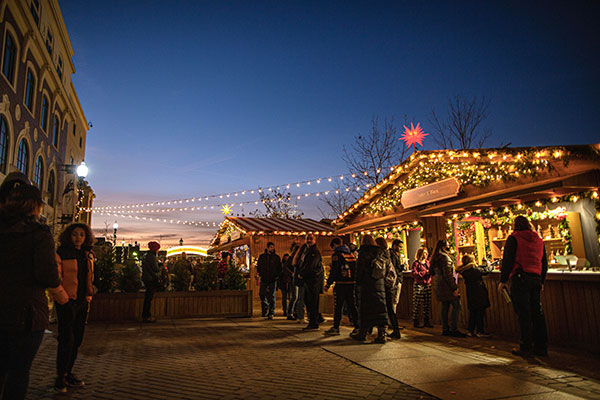There are so many beautiful places in and around Indianapolis to enjoy the great outdoors. We have dozens of parks, jogging paths, lakes, bike trails, and outside venues—so many that it might take years to visit them all. But perhaps Indy’s greatest outdoor attraction—and certainly the largest—is Eagle Creek Park.

Located just outside I-465 on the northwest side of the city, Eagle Creek is the crown jewel of all the Indy parks. With more than 5,000 sprawling acres of forested land and lakes, its magnificent beauty is something any nature lover should see. But the park might look a lot different today—or might not be here at all—if it weren’t for our founder: B.T. Engledow.
In the Beginning
The story of Eagle Creek Park starts in 1934 when J.K. Lilly Jr. bought 12 acres of land on the northwest side of Indianapolis. Originally, he called the land Eagle Crest and built several structures that remain today, including a cabin and a library that now serves as the park’s Ornithology Center. Over the next few years, J.K. would go on to acquire several adjacent farms in the area, and soon he had purchased more than 3,000 acres of land.
It was around this time that J.K. met a young entrepreneur named B.T. Engledow, who had recently started his own landscaping business after buying some tools and a $50 truck. While the happenstance of J.K. and B.T.’s first meeting is lost to time, there’s no doubt the young, upstart landscaper made a big impression on one of Indianapolis’s most influential people.
The Right Guy for the Job
Given B.T.’s ambition, honesty, and hard-working nature, his growing business relationship with J.K. Lilly wouldn’t have been much of a surprise to anyone who knew him well.

“B.T. was a high school dropout with zero business education, but his many positive attributes helped him attract plenty of clients,” said Jack Engledow, B.T.’s oldest son and former president of Engledow. “There was a true entrepreneurial spirit about him, and he was willing to try almost anything new. He had no noticeable fear of risk.”
Before long, B.T. was carrying out J.K.’s vision for Eagle Crest: transforming it from tilled farmland into a natural forest preserve. Given the thousands of acres that would need to be covered with plant life—and the two man-made lakes that were to be constructed—this was no small job. In fact, the transformation would take many years.
“As he worked on the project, my dad would take us out to Eagle Crest to see what was going on,” said Jack. “From the late 1930s up until the start of World War II, B.T. and his crew planted thousands of native Indiana forest trees on the land, including the beautiful walnut groves you see today. On top of that, they did lots of landscaping—much of what B.T. did is still around.”
J.K. Lilly loved Eagle Crest so much that he had his own retreat house right there on the property. It was a place to relax, reflect, and enjoy the beautiful forest preserve he’d worked so hard to create.
“The retreat Mr. Lilly had at Eagle Crest was a wonderful place,” said Jack. “It was home to some world-class collections of stamps, coins, and miniature soldiers that were arranged to depict famous battlefields throughout history. He also had a large library that became the basis for the Lilly Library in Bloomington. It was quite special to him.”
Carrying on Tradition

In 1950, B.T. would pass away, ending a long battle with tuberculosis at the young age of 42. But the family business would continue to plant trees and perform landscaping duties at Eagle Crest until 1958, when the land was donated to Purdue University.
Purdue would continue to hold the property until it was acquired by the City of Indianapolis during the 1960s. The City wanted the land not only for its use as a municipal park, but also so they could dam the Eagle Creek reservoir to prevent flooding. By 1970, the City had acquired most of the land that currently constitutes the park, and they had opened the reservoir for public use. In 1972, Mayor Dick Lugar officially opened the nature reserve with its new name: Eagle Creek Park.
Today, thanks to active conservation efforts by the City, Eagle Creek is pretty similar to what it was when B.T. was working there back in the 1930s and 1940s. Sure, the trees might be a little bigger. And there might be a few more joggers and bicyclists. But that awe-inspiring feeling you get when you go there is exactly the same as it was nearly 80 years ago when B.T. was spending his days planting walnut seeds.
“We’ve been lucky to have family members who really have an interest in plants, and a passion for moving our business forward. We’ve had hundreds of good people over time—in fact, I think we have the best people,” said Jack. “It all started with B.T.”
If you want to know a little bit more about our history with Eagle Creek, check out this short video. And if you’re looking for help with your landscape—or just want to be regaled with more stories about the history of our company—we’d love to talk. Contact us today to learn more.

